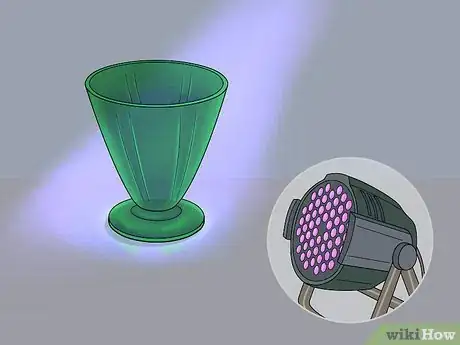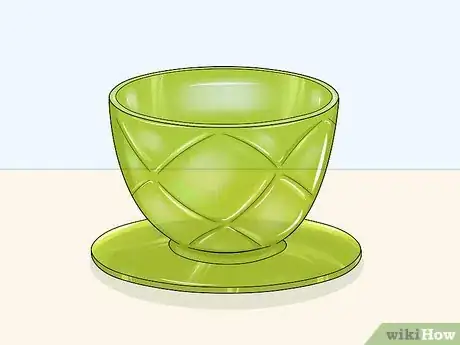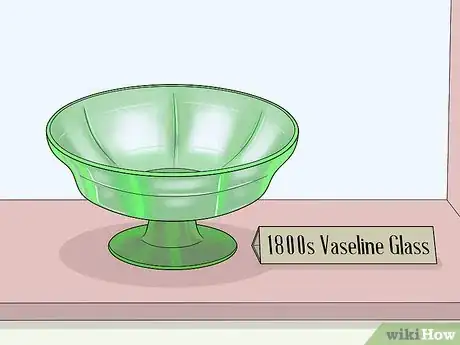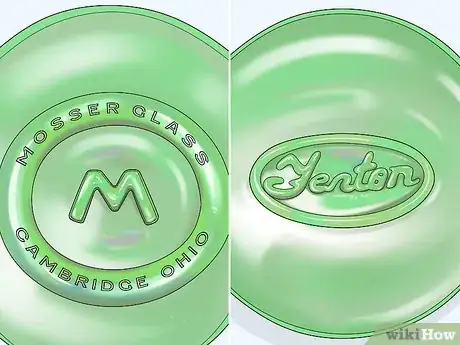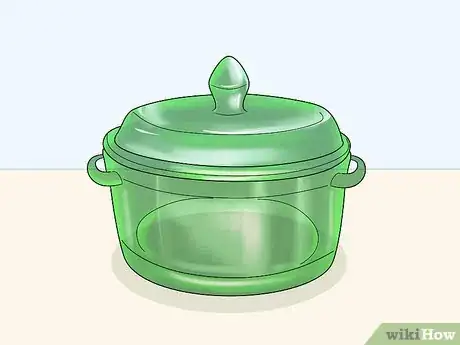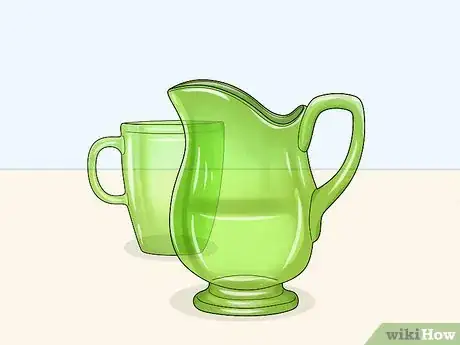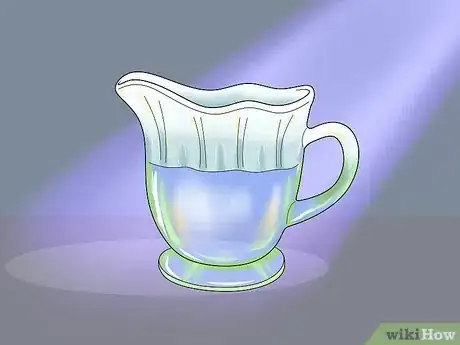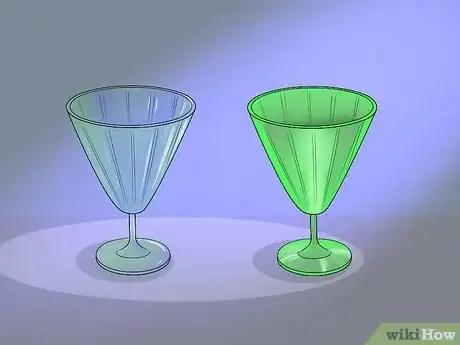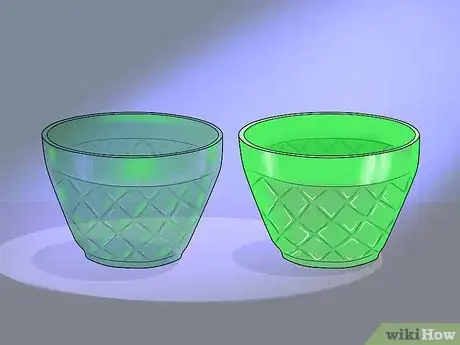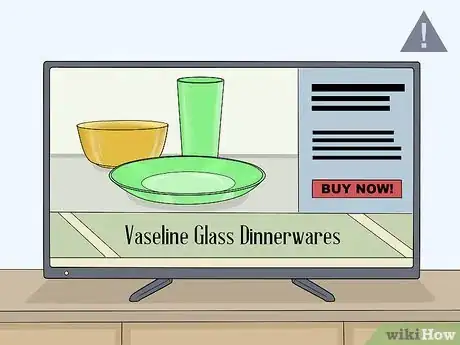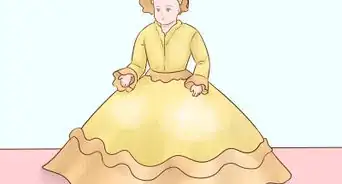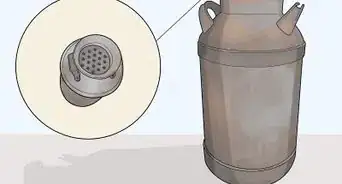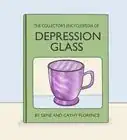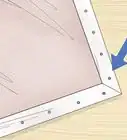This article was co-authored by wikiHow staff writer, Hannah Madden. Hannah Madden is a writer, editor, and artist currently living in Portland, Oregon. In 2018, she graduated from Portland State University with a B.S. in Environmental Studies. Hannah enjoys writing articles about conservation, sustainability, and eco-friendly products. When she isn’t writing, you can find Hannah working on hand embroidery projects and listening to music.
This article has been viewed 89,174 times.
Learn more...
If you love antiquing, you may have stumbled upon some glass pieces that glow yellow or green glow in the sun. This is called vaseline glass and it has a small amount of uranium in it. Don't worry, the glass isn't dangerous—but it is collectible. Vaseline glass got its name because of its yellow-green, oily color, which looks similar to the original formula of Vaseline. Fortunately, vaseline glass is pretty easy to identify with a UV light.[1]
Steps
Looking for the Characteristics of Vaseline Glass
-
1Shine a UV light on it to look for a bright green color. Use a blacklight to identify the uranium in vaseline glass. Shine your UV light on the glass piece and look for a neon green glowing color.[2]
- Using a black light is the only sure way to identify vaseline glass.
- Other glass pieces may turn green under a black light, but they will not glow like vaseline glass does.
- Remember the phrase, “if it doesn’t glow green, it’s not vaseline.”
Tip: Carry a small handheld blacklight with you to look for vaseline glass when you are out and about.
-
2Find glass that has a yellow-green, oily sheen to it. The outside of vaseline glass usually looks slightly oily or shiny in natural light with a tinge of yellow or green color, especially if it was made in the 20th century. Modern vaseline glass can be clear or blue as well.[3]
- Its oily sheen is part of the reason why it is named vaseline glass, because petroleum jelly has a slightly oily sheen as well.[4]
Advertisement -
3Look for glass made in the late 1800s. Traditional vaseline glass started in the early 1800s, but reached its peak in 1880. If the glass has a date stamped on it anywhere and it is between 1850 and 1880, there is a good chance that it is vaseline glass.[5]
- Vaseline glass was restricted in 1958, so while it is still being made today, it is not nearly as prevalent.
-
4Find glass that is produced by Mosser or Fenton. These 2 glass companies are the most prevalent producers of vaseline glass in modern times. If you find a glass piece stamped with their brand, there is a good chance it is vaseline glass.[6]
- Mosser and Fenton also make other glass items that aren’t vaseline glass.
-
5Look for cookware pieces made of glass. Vaseline glass is often used to make serving bowls, plates, and pitchers, especially if it is from the 20th century. Modern vaseline glass is usually used to make small statues and ornamental pieces.[7]
- Although vaseline glass isn’t radioactive, you should avoid eating or drinking out of it.
-
6Make sure the glass is translucent. Vaseline glass is almost always translucent, meaning you can see through it. Look for glass that light shines through to identify vaseline glass.[8]
- If the glass piece is opaque, there is a good chance it is depression glass, not vaseline.
Recognizing Similar Types of Glass
-
1Watch for a white glow to find golden opaline. The most common glass that is mistaken for vaseline glass glows white under a UV light, not green. Although it does glow, it will stay bright white, not yellow or green.[9]
Tip: This glass is sometimes called vaseline opalescent since it looks so much like vaseline glass.
-
2Identify depression glass by its dull color under UV light. Depression glass looks similar to vaseline glass in natural light, but it won’t glow green under UV rays. Use your blacklight to distinguish between these glass pieces.[10]
- Depression glass is a collector’s item, but it isn’t quite as expensive as vaseline glass.
-
3Find fluorescent glass by looking for a softer glow. Fluorescent glass will glow slightly under UV light, but it won’t be as bright or as green as vaseline glass. Look for a softer, more natural glow to distinguish between fluorescent and vaseline glass.[11]
- Fluorescent glass is often amber-colored and more opaque than vaseline glass.
-
4Watch for fakes advertised as modern dinnerware. If there is a glass piece advertised as a modern piece and it is a drinking glass, plate, pitcher, or serving dish, it is most likely fake. Although there are companies that make vaseline glass still, they are all decorative pieces.[12]
- Most production of vaseline glass after 1959 is purely decorative.
References
- ↑ https://www.vaselineglass.org/?page_id=35
- ↑ https://www.vaselineglass.org/?page_id=35
- ↑ https://www.orau.org/ptp/collection/consumer%20products/vaseline.htm
- ↑ https://www.chicagotribune.com/news/ct-xpm-2002-03-24-0203240039-story.html
- ↑ https://www.orau.org/ptp/collection/consumer%20products/vaseline.htm
- ↑ http://glasscollie.com/how-to-identify-vaseline-glass/
- ↑ https://www.orau.org/ptp/collection/consumer%20products/vaseline.htm
- ↑ https://www.20thcenturyglass.com/glass_encyclopedia/vaseline_glass/vaselineglass_home.htm
- ↑ http://glasscollie.com/how-to-identify-vaseline-glass/
